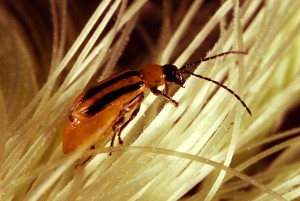
LOS ANGELES — In a case of evolution outfoxing agricultural biotechnology, a voracious rootworm that was supposed to be poisoned by genetically-modified corn has become resistant to the toxins produced by the plant.
Populations of western corn rootworms, which used to cause billions of dollars in damage to U.S. crops, plummeted across the Midwest after Bt corn engineered to produce insecticidal toxins from the bacterium Bacillus thuringiensis was first planted in 1996. The toxins killed the worms and reduced the use of conventional pesticides, helping to make Bt corn so popular that it now accounts for three-quarters of the U.S. corn crop.

But according to a new study by entomologists at Iowa State University, the rootworm has rapidly developed a resistance to the toxins, with potentially disastrous consequences for farmers and the environment.
“Unless management practices change, it’s only going to get worse,” Aaron Gassmann, a co-author of the study, told Wired. “There needs to be a fundamental change in how the technology is used.”
Gassmann has been studying Bt-resistant worms since 2009, when he looked into reports of extensive rootworm damage in Bt cornfields in northeast Iowa. Resistance has also been reported in parts of Illinois, Minnesota, Nebraska and South Dakota. The new paper describes further incidents of resistance in other parts of Iowa.
“These first cases of resistance by western corn rootworm highlight the vulnerability of Bt maize to further evolution of resistance from this pest,” the study said.
Entomologists told Wired that the resistance is the result of farmers failing to set aside refuges where non-Bt corn could be planted, and biotech companies not enforcing the planting of refuges.
Within the non-Bt fields, Wired noted, rootworms would remain susceptible to the Bt toxin. By mating with any Bt-resistant worms that chanced to evolve in neighboring fields, they would prevent resistance from building up in the gene pool.
“Biotech companies have successfully lobbied [the U.S. Environmental Protection Agency] for major reductions in refuge requirements,” said entomologist Bruce Tabashnik of the University of Arizona. He and other scientists have pushed the EPA to double the current requirements, but so far without success.
Farmers likely won’t stop using Bt corn because it is still effective against other pests. But as rootworms become more resistant, Gassmann said, farmers will turn to insecticides, increasing their costs and forfeiting the ecological benefits originally gained by using Bt corn.
The results of the new study “illustrate that Bt crops producing less than a high dose of toxin against target pests may select for resistance rapidly; consequently, current approaches for managing Bt resistance should be reexamined,” the Iowa State researchers concluded.

